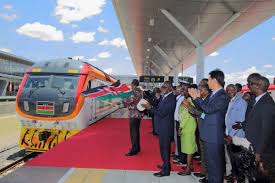Published: June13,2022

The Chinese-built 480-km Mombasa-Nairobi Standard Gauge Railway (SGR) has been at the heart of Kenya’s quest for economic revival, five years after its launch on May 31, 2017, a railway official has said.
James Siele, Kenya Railways Business, Commercial & Operations Expert-Team leader, said the China-built modern railway line has injected vitality into the local economy through the seamless movement of bulk cargo and passengers, including tourists and skilled workforce.
During a recent interview with Xinhua ahead of the 5th anniversary since the launch of SGR, Siele noted the railway line had reduced the cost of doing business in the country, eased the backlog at the port of Mombasa and enhanced the competitiveness of locally manufactured goods in the overseas markets.
Siele disclosed that it now takes eight hours to transport cargo from the port of Mombasa to Nairobi using the modern railway as opposed to three days through the century-old meter gauge railway.
He noted that efficient, safe and speedy hauling of bulk through the SGR has been a boon to manufacturers since they no longer have to invest in costly warehousing and insurance policies.
“With the coming of the SGR, the cargo is delivered just in time either for production or for sale and this means that the businesses are not investing in security and insurances for holding stocks,” Siele remarked.
One freight train has eliminated the use of 110 trucks for transporting bulk cargo by road from the port of Mombasa to Nairobi, boosting Kenya’s carbon emission reduction goals, said Siele.
He added that no accident has been reported since the operationa of the Mombasa-Nairobi SGR five years ago, a feat that has been achieved courtesy of meticulous planning.
According to Siele, the SGR passenger trains and freight trains had transported 7.78 million passengers and 18.8 million tons of bulk cargo respectively along the Mombasa-Nairobi corridor in the last five years.
He revealed that the SGR is currently able to haul about 40 percent of cargo from the port of Mombasa to the hinterland, compared to a partly 4 percent that used to pass through the century-old meter gauge railway.
Some of the strategic sectors of the economy that have gained from SGR passenger and cargo operations include manufacturing, agriculture and tourism, said Siele.
The SGR freight service has also been delivering fertilizer to local farmers at a reduced cost and in the last two years, it has been transporting tea to the port of Mombasa for export, cutting down on huge expenses incurred through road transport, said Siele.
He added that the modern railway has also benefitted local millers, who no longer travel to the port of Mombasa to obtain imported wheat since it is delivered to their doorstep in the capital Nairobi in a timely manner.
Siele singled out the 120-kilometer Nairobi-Suswa SGR line, which is part of the Mombasa-Nairobi-Malaba SGR project, for facilitating the movement of a skilled workforce from the outskirts of the capital to its business and industrial hubs.
He attributed seamless operations of the Mombasa-Nairobi SGR to proper planning, robust manpower and enhanced coordination among state agencies including ports and customs authorities.
Government statistics indicate that Kenya’s Gross Domestic Product(GDP) grew by 1.5 percent in the aftermath of the Mombasa-Nairobi SGR launch as the project created 46,000 jobs for local citizens.
Siele noted that knowledge, skills and technology transfer coupled with improved cross-cultural interactions were among direct benefits the modern railway unleashed in the country.
“We have benefitted immensely from skills transfer, our Kenyan people have been trained to operate the trains efficiently,” said Siele.
“The manpower we have is mostly Chinese trained and they are doing a commendable job. The skills transfer has been ongoing,” he added.
He said the SGR had a brighter future in Kenya, the East African region and the whole of Africa since it is envisaged to enhance connectivity, cross-border trade and free movement of skilled labor.
According to Siele, the SGR will in the future be linked to the new Lamu Port in the Kenyan coast and extend to the landlocked neighboring countries of South Sudan and Ethiopia.
He added that the ultimate goal will be to link SGR to a land bridge, connecting the Indian Ocean to the West Coast of Africa and enhancing the movement of agricultural commodities and minerals in a huge swathe of the continent.
Xinhua
 Africa -China Review Africa -China Cooperation and Transformation
Africa -China Review Africa -China Cooperation and Transformation
